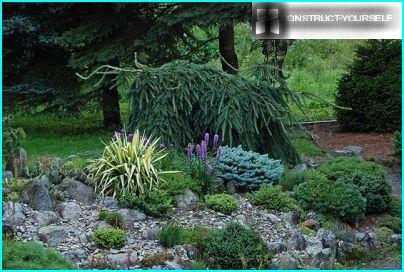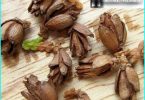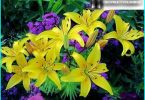The contents
Spherical, pyramidal, conical, weeping or creeping – the shape of the crown of juniper can be any that enhances the landscape design in the formation of compositions, expressive in its geometry. Combining only conifers, you can capture the original garden, bright identity and style: infinity or regular, avant-garde or classic, ethnic or modernist.
Rock garden, created with a combination of juniper with other species of conifers, will look excellent in any season
Conifers advantageous adorn the gardens, creating a quiet and elegant landscape. Large conical or columnar junipers are good in single or group planting, acting as the center of landscape composition. Looks catchy single juniper in the form of a topiary. A single overall plant is always a dominant feature in garden design, which it is desirable to surround the smaller plants.
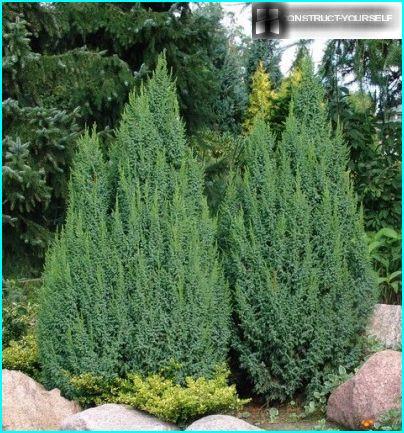
Group planting the scaly juniper varieties Loderi its conical crown adds to the song rockeries
Junipers with foliage geometric shapes look good in gardens with a regular layout, creating specific points and emphasizing the correctness of the outlines of the flowerbeds. Landscape gardens of conical and spherical junipers are the perfect complement to less «the semi-official» plants, perennials, and spreading in the form of a grade will give the border, the rock garden or pond expressiveness.
They are often used in planting hedges (molded, free-growing) and mixed borders, making the front end of the Alpine hills and ridges, to contour the borders of lawns or flower beds.
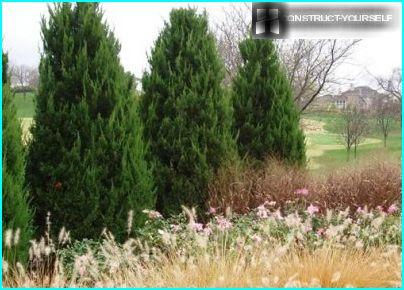
Combining the shaped and unshaped juniper with exotic foliage to create a spectacular rockery
Dwarf junipers in a compact bonsai and topiary are indispensable for laying the gardens in Oriental style they decorate a rocky composition and branching paths, advantageously combined with groundcover and low-growing plants: a saxifrage, Verbania, stonecrop, carnations, Phlox and grasses.
Junipers with a beautiful color of crown:
- blue silver rock juniper varieties Blue Arrow,
- glaucous-blue Meyeri and Blue Carpet,
- bluish-grey rock grade Skyrocket,
- horizontal juniper some species (Andorra Compact Blue Chip) in winter becomes violet,
- spreading juniper Golden tones Pfitzeriana Aurea advantageous to look at the background of grass.
Spectacular crown junipers do not require frequent pruning, but the varieties growing in the hedges, mow regularly: in the middle of summer and in the spring, removing dry and some of the side branches, beyond the limits of the formed crown. If juniper grows in the garden as bonsai, the haircut is performed in April-may and October-November.
The selection of varieties of juniper for planting
When choosing a juniper for planting in the garden, you must have complete information about its characteristics: winter hardiness, size of plants in the adult form, shape and color of the crown, growing conditions and care. Junipers, which are brought to us from Western nurseries, can be quite resistant to typical for Central Russia harsh winters and nezametnye successfully growing without shelter only in the southern regions.
After you purchase a new coniferous plants (even frost) experienced gardeners recommend to hide it on the first winter fir spruce branches or burlap using strings branches to avoid sunburn of needles and damage to the crowns from snow.

Juniper the average grade of the gold coast, with Golden needles, expressive contrasts with a more emerald green
The staff of the Botanical gardens of Russia has identified suitable and unsuitable for cultivation in domestic latitudes, varieties of juniper.
Hardy species of juniper (Juniperus):
- common (J. Communis),
- Cossack (J. Sabina),
- flake (J. Squmata),
- horizontal (J. Horizontalis),
- Siberian (J. Sibirica),
- Chinese (J. Chinensis),
- hard (J. Rigida),
- virgin (J. Virginiana).
Nezametnye species of juniper:
- Turkestan (J. Turkestanica),
- leaning (J. Procumbens),
- Zeravshan (J. Seravshanica),
- red (J. Oxycedrus).
Successful rooting and growth of juniper largely depends on the quality of the purchased seedlings. When purchasing planting material should pay attention to the following points:
- Plants with open root system is better not to buy.
- It is advisable to purchase the juniper in a container or with a clod of earth wrapped in burlap.
- From the root system and branches must be visible growth of the current year.
- The stem should not be cracking.
- Fresh shoots should be flexible and unbreakable.
- The color of the crown should be even, without brown patches and white flakes at the base of pine needles.
- It is recommended to choose those plants which were grown in the container and not in open soil, and then transplanted into a container.
Juniper bushes with open root system are planted in early spring or fall, and seedlings with a clod of earth – throughout the period from spring to autumn. In Northern regions of optimal planting in the spring so the plant has time to settle down to more successfully survive winter.

Combining juniper with different colored needles, you can create unusual colors and form a hedge
The technology of planting
Due to its ornamental junipers is a good choice for young gardens, when the group of the few conifers able to immediately after planting to fill the void in the landscape and form an attractive composition. For planting light-demanding juniper select an open, well-lit area of the garden with sandy loam or light soil – nutrients and moist.

A living fence formed from silver-blue juniper will be the eye-catching element of landscape design garden
If the soil is clayey and heavy, in the planting hole add a mixture of garden soil, peat, sand and pine land (loose soil with needles collected under fir or pine trees in a forest). In this pre-drained soil and covered at the bottom of the planting hole broken bricks or sand. Junipers grow well and on the skinny soils can easily tolerate drought, but the water stagnation in the soil are harmful for them.
The most successful mixture of soil for planting of juniper: 2 pieces of sod land, 2 parts humus, 2 parts peat, 1 part sand. It is also desirable to add in a mixture of 150 g Kemira-universal and 300 g of nitrophoska and Appin after planting (for optimal survival) for each seedling.

Horizontal junipers with flattened crown successfully entered in the design area by the pond
Dimensions of planting holes depends on the size of the root system of juniper, for example, for larger species dig a hole about 60?80 cm Planted the plant quickly, so the root system has not had time to dry, but be careful not to damage the earthen or young roots. After planting in open ground juniper abundantly watered and protected from direct sunlight.
The density of the placement of juniper in the area depends on landscape composition – whether it is a hedge, solitary or group planting. For junipers, the distance between the seedlings when planting is selected in the range from 0.5 to 2 m For a small garden it is better to stay compact types juniper.
Growing a juniper from seed
When collecting seed juniper for planting, it is important to observe the time intervals – it is better to prepare not quite ripened seeds in late summer, what finally ripened in the autumn. So the probability of germination will be more. Harvested planting material must be immediately sown, but you need to be prepared for the fact that because of the hard shell juniper seeds germinate only 2-3 years after sowing.

Group planting Chinese juniper will enliven the garden in the off season and winter
You can put on the site a juniper, dug in the woods, pre-marking on its trunk, the orientation of the parts of light to best simulate when transplanting the peculiarities of its growth in the natural environment. Kom «native» the land should be large, with the saved top layer of humus.
How to properly apply fertilizer
When selecting varieties of juniper that are resistant to local climatic conditions, care of young plants minimum junipers almost sick and not affected by pests, do not require intensive fertilizing and spraying. Further, it is sufficient only to provide watering of the juniper in dry years and 2-3 times per season to maintain its nitrogen or complex fertilizer.
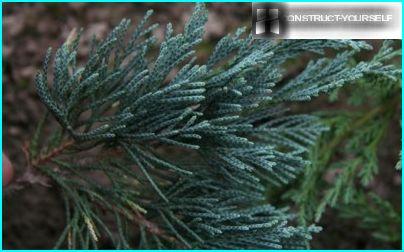
Different varieties of junipers have different colored needles, but looks especially beautiful needles of a bluish-white color
In any case it is impossible to fertilize conifers bird or cow humus – from the roots of juniper burn, and the plant dies. Also, we loosen the soil around junipers – due to the fact that the root system of the conifers belong to the superficial type, the power trunk will deteriorate and the plant begins to wither. For juniper, it is sufficient to mulch the soil with pine land harvested in the woods.
Care in winter
In the winter time formed the crowns of the junipers under the weight of snow can break up some branches to break. To avoid such troubles, crown moulding junipers in the fall pre-tied. Certain types of junipers are sensitive to fluctuations in day and night temperature in early spring, winter and spring sun and require shelter in February-March. Burns of pine needles lead to change in the green crowns of the conifers on the brown yellow and, consequently, to the loss of decorative juniper.
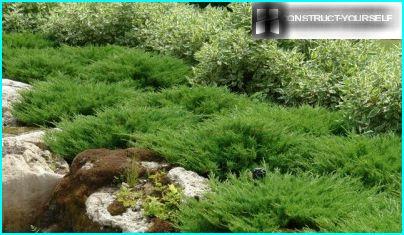
Horizontal juniper varieties Plumosa acts as a groundcover for the rock garden
If the kidneys of ephedra with sunburn stay alive, the young shoots gradually covering the burnt places, but if the buds are killed, victims of frosts the branches must be cut to healthy wood and processed garden pitch.
To needles of juniper kept the brightness in winter, the plant should be regularly watered, fertilized in spring and in late summer granular baits, and foliage spray of micronutrients.
Growers make a practice of such types of cover juniper for the winter:
- Snow. A great option for petite and creeping forms – just throw the snow on the branches of ephedra. But when heavy snowfall it is recommended to make a protective frame.
- Spruce branches. Fixed to the branches of the tiers, moving from the bottom to the top of juniper.
- Woven and non-woven materials. Conifers spunbond wrap, burlap, Kraft paper (two layers), light cotton fabric and tie with rope, leaving the lower part of the crown open. The tape cannot be used – the plant will rot.
- Screen. Installed with the most lit side of the plant.
To shelter juniper is not suitable was lutrasil – he misses sunlight, not very good also shelter from cardboard boxes. The experience of gardeners, as a shelter for conifers great metallic insulation, used for laminate flooring. To do this in October (while the ground is still frozen) around juniper drive in the pegs and the pad itself is wrapped up in the plant in November.
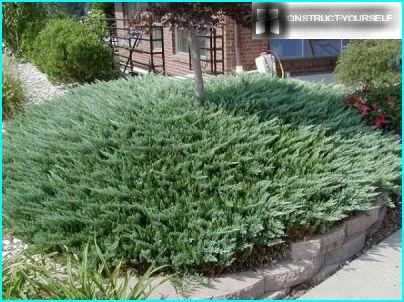
Horizontal juniper Bar Harbor with a rounded crown effectively complements soliternyh planting deciduous
Frost-resistant species of juniper, does not burn in the sun: the Cossack, the average grade (of Hatti, old gold, mint Julep), Chinese gold star, grades Pendula and Pfitzeriana. Much burn in winter and spring the sun is a subspecies of Juniperus.
The location in the flower bed: 8 beautiful schemes
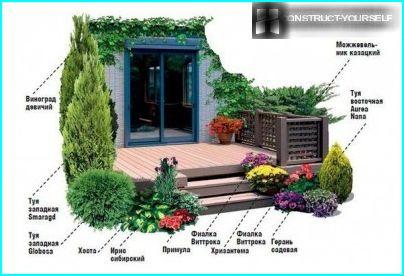
Juniper Cossack — one of the hardiest varieties, suitable for planting in Central Russia
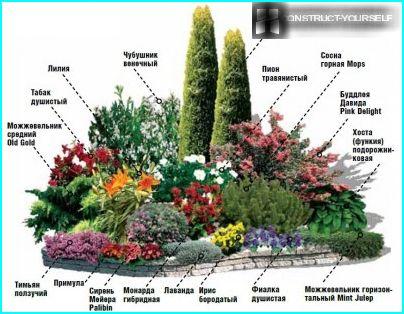
Columnar juniper of Chimerica acts as a focal point in the flower bed
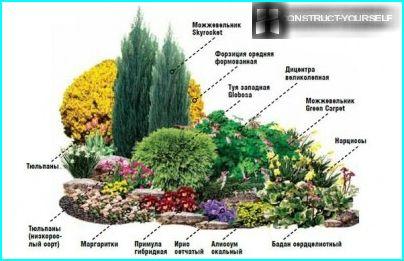
On a bed you can combine several types of juniper: rocky, horizontal, Chinese — any combination will be successful
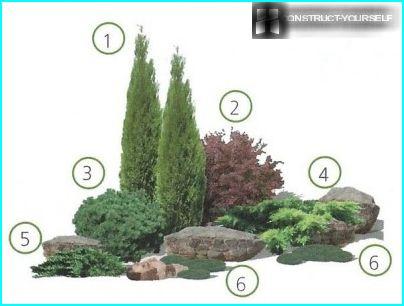
1. Thuja occidentalis «Holmstrup». 2. Barberry Thunberg «Red Chief». 3. Pine mountain «Mops». 4. Juniper medium «Old Gold». 5. Cossack juniper «Tamariscifolia». 6. Groundcover perennials (bryozoans, stonecrop)
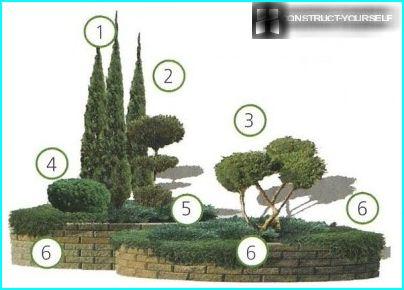
1. Juniper rock «Blue Arrow». 2. Juniper rock molded «Skyrocket». 3. Juniper scaly molded «Meyeri». 4. Pine mountain «Mops». 5. Horizontal juniper «Blue Chip». 6. Juniper leans «Nana»
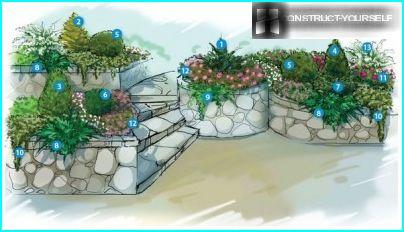
1. Juniper Chinese «Blaauw» or «Blue Alps». 2. Thuja occidentalis «Stolwijk» or «Rheingold». 3. Thuja orientalis «Aurea Nana». 4. Spruce canadian «Conica». 5. Thuja occidentalis «Tiny Tim» or «Little Champion». 6. Pine mountain «Gnom». 7. Blue spruce «Glauca Globosa» or European «Nidiformis». 8. Horizontal juniper «Blue Chip» or «Prince of Wales». 9. Horizontal juniper «Wiltonii». 10. The Cotoneaster Of Dammara. 11. Groundcover roses. 12. Flowers: Petunia, Phlox subulate, obrieta, thyme, vervain. 13. Spiraea «Snowmound»
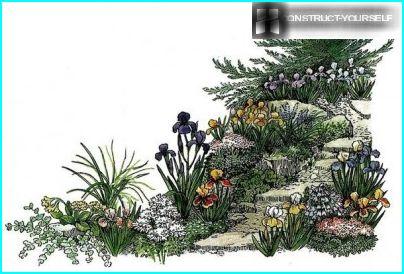
Juniper original crown plays the role of accent on the Alpine hill
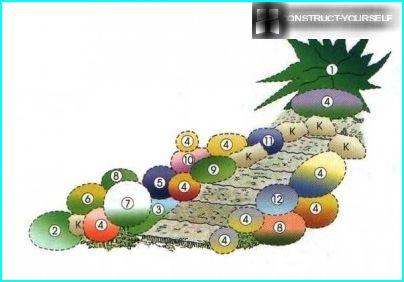
1. Juniper Cossack molded. 2. Stonecrop Siebold. 3. Sedum. 4. Iris dwarf. 5. Iris garden (bearded, average height). 6. Primula Ushkovo. 7. Iberis evergreen. 8. Lugovik soddy. 9. The young hybrid. 10. Saxifraga soddy. 11. Muscari homolkova. 12. Bell lozhechnitselistny
The types and varieties of juniper
Decorative planting of junipers significantly depends on the properly selected varieties of its dimensions taking into account growth, crown shape, color and texture of pine needles. Varieties belonging to the same species of junipers, can differ substantially in their external characteristics is also worth considering.
Juniper scaly:
- Meyer. Height 1 m, growth rate 10 cm per year. The needles are silvery-blue. The mixed borders and bonsai.
- Blue Carpet. Height 0.6 m, diameter 2-2.5 m. Creeping branched crown. The needles are silvery blue. Unpretentious, grows quickly. The lower tier landscape compositions.
Juniper medium:
- Old Gold. Height 0.4 m, diameter 1 m. Broad rounded crown yellow gold color. Single landing on the lawn, in the rock garden.
- Mint Julep. Height 1.5 m, diameter of 2-3 m Spreading crown with curved branches and a scaly green needles. Group planting, Alpine slides, quilting tall bushes.
- Gold Star. Height 1 m, diameter 2.5 m. low shrubs with a spreading crown and needles of a Golden-green tone. Low haircut or unshaped hedges, decorating gutters and drainage wells.
- Pfitzeriana compact. Height 0.8 m, diameter 1.5-2 m. the crown is Spreading, needle-like green needles. Fast growing, tolerates shearing. Borders, clumps of evergreens with different color needles, shaped and unshaped hedges, the organization of the lower layer in large-scale landscape compositions.
Juniper virgin:
- Getz. Height 1 m, Diameter 2-2.5 m. the growth of 30 cm per year. A spreading rounded crown with scaly silvery-blue needles. It tolerates a haircut. Single and group planting.
- Canaertii. The altitude of 5-7 meters, diameter of 2-3 m, Annual growth 30 cm Column-like crown with dark green needles. Specimen, groups, hedges.
- Gray Owl. Height 1m, diameter of 2.5 m. an Increase of 20 cm per year. A spreading crown with scaly silvery-blue needles and purple shoots. Molded composition.
Horizontal juniper:
- Blue Chip. Height 0.4 m, diameter 2 m. dwarf shrub with acicular needles glaucous-blue tone. Rock gardens, Heather gardens, retaining walls.
- Blue Forest. Height 0.3 m, diameter 1.5. Creeping groundcover crown with blue needles. Strengthening of the slopes, lower rock gardens, container planting.
- Andorra compact. Height 0.4 m, diameter 1.5 m cushion Ploskookrugloy crown with blue-gray scaly needles. Low borders, decorating the slopes and tiers garden.
- Andorra compact Variegata. Height 0.4 m, diameter 1.5 m Cushion crown with radiant stems and bright-green needles with whitish patches on the tips of the branches. Mixed groups, rock gardens.
- Wilton. Height 0.1 m, diameter 2 m. Branching groundcover crown with silvery green needles. Large groups, rock gardens, juniper lawns.
Chinese juniper:
- Strikta. Height 2.5 m, diameter 1.5 m Conical crown with greenish-blue needles. Single and group planting, cultivation in pots.
- Obelisk. Height 3 m, diameter 1.2-1.5 m crown Columnar, bluish-green needles.
- Monarch. Height 2 m, diameter 1.5 m Asymmetrical columnar crown. Single and group planting.
- Kuriwao Gold. Height 2 m, diameter 2 m Spreading crown rounded openwork shape with green needles and young shoots Golden. A single planting of mixed and coniferous groups, rock gardens.
Juniper rock Skyrocket. Height 3 m, diameter 0.7 m. Annual growth of 10-20 cm. Pyramidal crown with short bluish-green needles. Vertical accent in rock gardens, Avenue plantings, on lawns, in contrasting compositions and hedges.
Common juniper Hibernica. Height 3-5 m, diameter 1-1.2 m. Columnar crown with bluish-steel of barbed needles. Specimen on lawns, group planting and composition with deciduous species.
Cossack juniper. Height 1 m, diameter 2 m Spreading crown with grassy-green needles. Hedges, single and group planting.
The variety of colors and shapes of junipers allows you to create a spectacular landscape composition, combining them with other coniferous and deciduous species of shrubs or trees as well as flowers and other garden plants.

